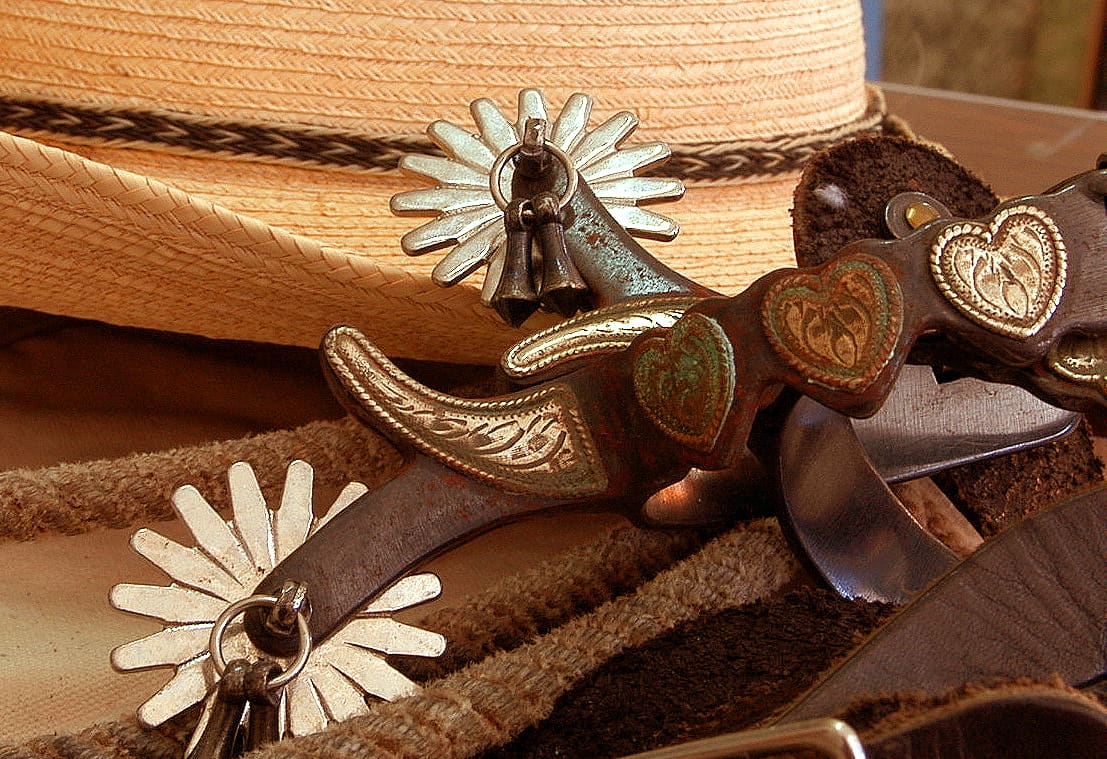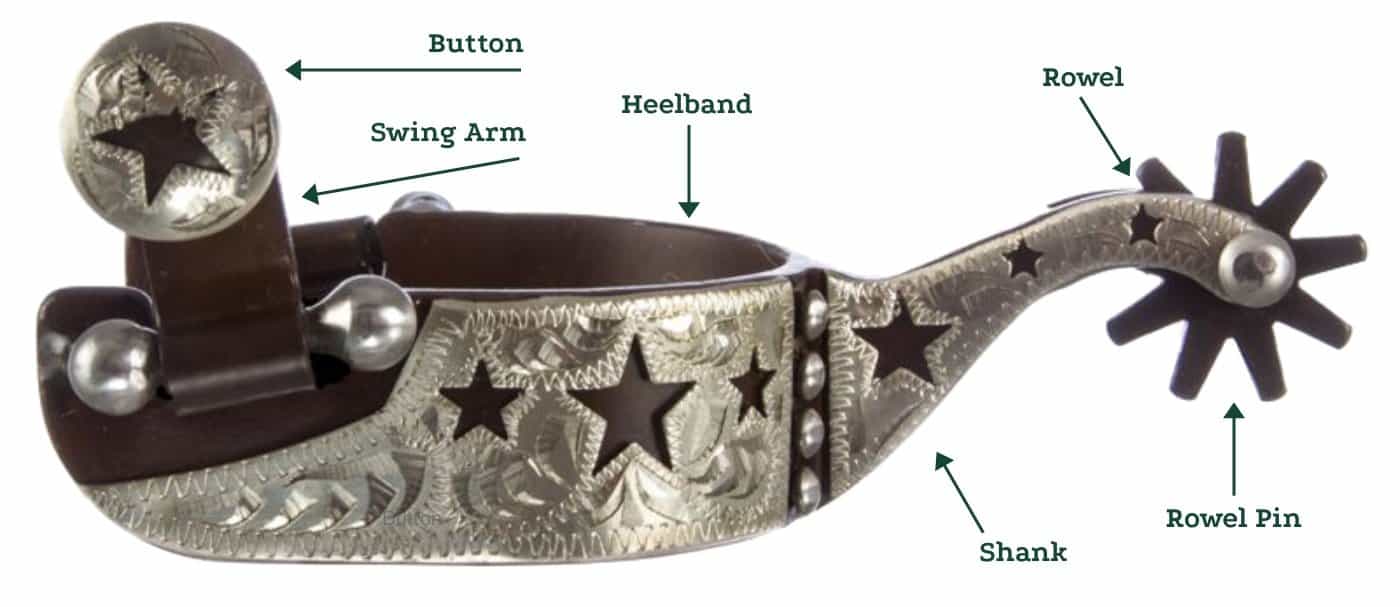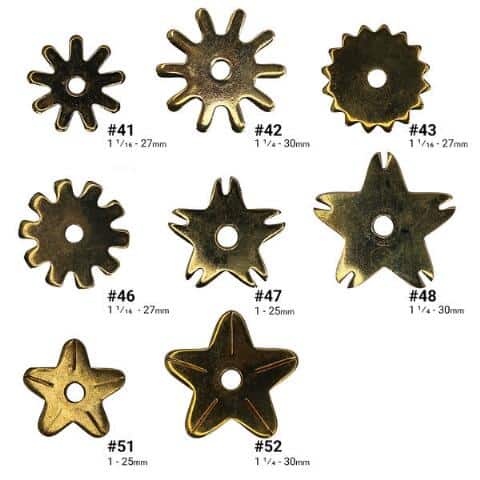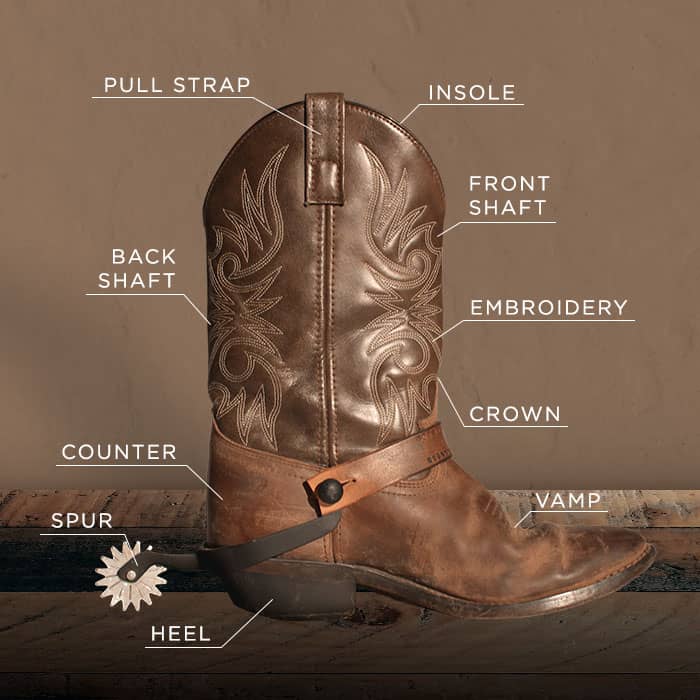You probably have a mental picture of what spurs look like. And it probably involves spinning that dial the way a cowboy spins his barrel when he’s playing shooting games. But what are spurs exactly, and why do cowboys wear them? We’ll answer all that and more.
So let’s start with the basics. Why do cowboys wear spurs? To communicate with the horse. This cowboy (or cowgirl) tool traces to the Celts, Romans, Moors, Conquistadors, Mexicans, and eventually the American West. Let’s look into this ‘cute’ little device and what it does.
Types of Cowboy Spurs
Spurs work by poking the side of the horse to get it to do what you want. This might mean the horse goes faster, slower, or shifts direction. The two main types of spurs are western spurs and eastern spurs, with sub-categories based on locality, style, function, or brand.
Eastern spurs generally have smaller rowels and less décor than western spurs. And older spurs often had sharper spikes because back then, there was less concern about animal rights. But even then, people with personal bonds to their horses were averse to using spurs.
A rider that knows their horse can control them in less forceful ways. Some horse whisperers can connect with a new horse in minutes, so they wouldn’t need spurs either. Spurs aren’t advisable for beginners – you’ll poke too hard. You can categorize your spurs according to:
- Function e.g. roping, reining, barrel racing, and pleasure-riding
- Location / Region e.g. California, Texas, English (e.g. Prince of Wales aka no rowel)
- Aesthetics and décor e.g. full-mounted (both sides), half-mounted (one side)
- Structural layout e.g. swan neck, Waterford neck, drop shank, etc.
- Shape e.g. round, knob, spike, flat, cloverleaf, disc, roller
- Aggression e.g. mild rollers /cloverleaf vs aggressive nine-pointers / rock grinders
In the Old West, spurs were sometimes given to show a cowboy’s skill or rank. Prestigious ones might have bits called jingle bobs to mark the rider’s mastery – they clink as you walk. Others might have a specific ‘logo’ to announce the ranch or blacksmith that forged them.
Parts of Cowboy Spurs
The kind of cowboy spurs you buy will depend on how you plan to use them. Most modern spurs have rowels, but older designs had balls or flat tips. But first, let’s learn the parts.
- Heel Band / Yoke / Branch
This half-round horseshoe-like U-band holds onto the back of your shoe. You can pull its arms apart or squeeze them closer so they fit around your boot. But they need a little give.
- Spur Strap / Spur Chain
This can be a leather band or a metal chain that holds the spur onto your boots. Straps typically wrap around the front of your boot while chains slip under the instep of the shoe.
- Chap Guard
Chaps (pronounced ‘shaps’) are pant-like leather leggings that you can wear on top of your jeans when you ride. They offer extra padding, warmth, and traction. Chap guards keep the spurs from getting snagged on your chaps, or even on your riding pants, dress, or skirt.
- Rowel
The rowel is the part of cowboy spurs that spins. It sits on a flexible hinge that lets it rotate freely to avoid hurting your horse. Rowels come in various designs but the basic idea is a spiked and/or star-shaped metal disc that sits on a central pivot. The edges are rounded.
- Rowel Pin Cover
Not all spurs have rowels – they might have a ball or a flat end instead. But they must have a cover. The cover holds the ball or spiked disc in place using a central anchor or pin as a pivot.
- Button
This administrative bit secures your strap to the rest of your spur. It can be a simple, subtle metal or a decorative fastener with carvings, colors, etchings, and other pretty designs.
- Swing Arm
This sounds fancy, but it’s just the piece of leather or metal that anchors the button to the yoke or heel band. Check it regularly because if it gets damaged or loose, the spur can fall off.
- Shank
The shank is the metal section that links your rowel to your heel band, branch, or yoke. It can slope downwards (drop shank), be extra-long (Prince of Wales shank), or lie horizontal.
The type of spurs you buy will be driven by your choice of riding boots. Make sure you get the right size and style for your needs. Start with smaller, milder ones, then work your way up.
How to Wear Cowboy Spurs
Spurs are like saddles – meaning you can ride with or without them. But not everyone can ride bareback … or spur-less. It’s a matter of culture, exposure, and experience, not just preference. Spurs are tied around the sides of your boot using a special type of fastening.
You’ll need a leather spur strap or a metal spur chain to attach these spurs to your boots. The straps generally go around the back of your boot and/or under the heel. Full-mounted spurs have decorative details on both sides, while half-mounted ones are only embellished outside.
The purpose of spurs is to control the pace of your horse. When you press your legs into the body of the horse, the metal bits touch the horse and force it to react the way you want. Milder spurs often have smooth, flat, or blunt edges to avoid breaking the horse’s skin.
You can even find spurs that have a roller ball instead of a rowel. You’ll hear horse trainers say you have to ‘earn your spurs’. This is sometimes about rank, and sometimes means you have to get the horse to trust you in other ways before you rush to poke things into its flanks.
Boots that go with spurs should have a spur ledge / ridge. It’s a tiny extension at the back of the boot that lets the heel band or yoke fit snugly. Without it, spurs would slip right off your feet. Check your spurs, its joints, and your boot buckle to be sure it’s all smooth and secure.
Spurs: Yay or Nay?
There isn’t a simple answer to whether or not you should use spurs. The real decider is how you use them. Some riders use spurs as a weapon. They expect complete, immediate, and unhesitant responses from their horses, and they use spurs to guarantee quick obedience.
Other riders see their horses more as partners than subjects. They prefer to connect with their horse on a soul level so they see spurs as a form of punishment and avoid them completely. Spurs can also influence the temperament of your horse, making them moody.
Whether you’re using spurs or not, the aim is to be gentle, firm, and confident in handling horses. So some teachers will advocate training with spurs because they force you to be gentle with the horse. It’s too easy to overdo it, so the spurs help you control yourself.
Your natural riding stance makes a difference too. Do you generally keep your heels in and toes out when you ride? Or do you leave them loose at your sides, parallel to the body of your horse? Neither is right or wrong – it’s about how you learned and whether you can change it.
It’s possible to adjust your typical foot position, but it takes ages and infinite patience because it can actually be painful before you master it. It may affect your feelings towards riding because you keep forgetting and that can frustrate you. But it does affect the horse.
If you always ride with your heels in and you insist on using spurs, they will constantly nag your horse, so the horse will either learn to ignore the digs … or they’ll resent you and may become bad-tempered. So until and unless you have your feet right, dodge spurs of you can!
Should You Wear Cowboy Spurs?
Why do cowboys wear spurs? Because it’s an easy way to control your horse. With a simple nudge of your ankle, you can effortlessly make the horse move faster or slower. You can even use your spurs as ‘brakes’ to make the horse instantly stop. That gives you a powerful feeling.
But is it a good idea to wear cowboy spurs? And do cowboy spurs hurt your horse? Not if you use them correctly. That doesn’t mean everyone should wear cowboy spurs though. You need care, confidence, experience, and lots of practice to use them without upsetting your horse.
And, of course, using spurs correctly depends on your riding style, the type of spurs you’ve bought, the kind of boots you ride in, and the personality of your horse. Using spurs for dressage or harnessing is different from using them to drive cattle or race cross-country.
Some animal activists find spurs harmful and cruel. And, of course, there are lots of others ways to manage your horse without digging your feet into its flanks. Experts can use reins, leg movements, strategic pats, or even certain words or tones of voice to control their horses.
While cowboy spurs aren’t mandatory, some sports like dressage insist on them. You can use fake spurs if you prefer. And with practice, you can safely use spurs in competitive scenarios. They can help you keep the horse calm and avoid the distraction of galleries and rodeo fans.
More Reasons to Wear Cowboy Spurs
Spurs are a quick, convenient way to speak to your horse in situations where words won’t work. They can be especially useful in emergencies because they tell the horse, ‘This is serious. I need to act fast. I need to act NOW!’ They help when it’s too rowdy or loud to talk.
It may help to remember that spurs haven’t always had spinning rowels. The earliest spurs had a single spike called a prick, and some English spurs still use a flat or rounded version of this angular tip. Even once rowels showed up, many were fixed versions, not spinning ones.
As you consider the best way to use spurs, think of those pointy pricks sticking the side of a horse. That doesn’t sound fun! Later, cowboy rowels had multiple spikes, but cowboys filed them blunt before each ride. Keeping that in mind, apply the slightest possible pressure.
Here are a few other scenarios where a cowboy or cowgirl might want to use spurs:
- You need the horse to speed up, slow down, or turn in a pinch.
- Your hands are busy (with weapons or lassos) so you need to use your legs.
- The rules of an event require you to use spurs (try fake ones if that’s allowed).
- Your first horse-riding lessons included spurs so you can’t do without them.
- You like them as a fashion statement, just like your boots and hat.
- You received them as a present and your gift-giver is coming over.
- They can cue your horse’s mood; spur-less for casual days and spurs for work.
Are there any reasons why you shouldn’t use spurs? Well, if you typically ride with your heels facing inward, then spurs would be a constant pain in your horse’s flank. They’re also not advisable for beginners because you’ll probably (a) overuse them and (b) press too hard.
How to Use Cowboy Spurs
By now, you probably understand why cowboys wear spurs. And not all horses respond the same way, meaning you have to train the specific horse to work with your spurs. So if you’re settled on using them yourself, here’s how you can safely and effectively use cowboy spurs:
- Use them for communication, not discipline.
- Practice keeping your foot parallel rather than heel-in-toe-out.
- Apply minimal force with your heels to avoid stressing out your steed.
- Use subtle, measured movements – never jerk or startle the horse.
- Try milder spurs with ‘softened’ edges, smooth tips, or roller balls.
- Opt for a press-and-release approach rather than continuous pressure.
- Combine the spurs with other directions (your voice, your hands, etc.)
- Only use the spurs as a last resort so that your horse knows it’s urgent.
- Inspect the spurs regularly and repair them if they get too sharp or loose.
Remember, a spur is intended for gentle use. It complements other horse directions like your riding crop, reins, bits, or even the saddle. So it’s intended as a secondary tool, not a primary one. When you’re using spurs, touch the horse as lightly as possible. Force is not your friend!
Which Spurs Should You Buy?
Spur styles range from simple no-rowel styles to intricately decorated ones with silver carvings and etched leather. Talk to your horse trainer – they can advise you on the best type of spurs for your horse’s personality, your chosen sport, or your typical tasks at the ranch.
Spurs make an amazing gift too, and you can get them personalized. You can pass spurs down as a family heirloom if they’re solidly constructed and well-maintained. And certain antique spurs can sell for thousands of dollars. Remember to regularly dull the sharp points!
What’s your favorite style of cowboy spurs? Show us some photos in the comments section!












Great info on spurs! I find their sound to be almost like music. Watch Festus on any Gunsmoke episode and just listen to his spurs sing.